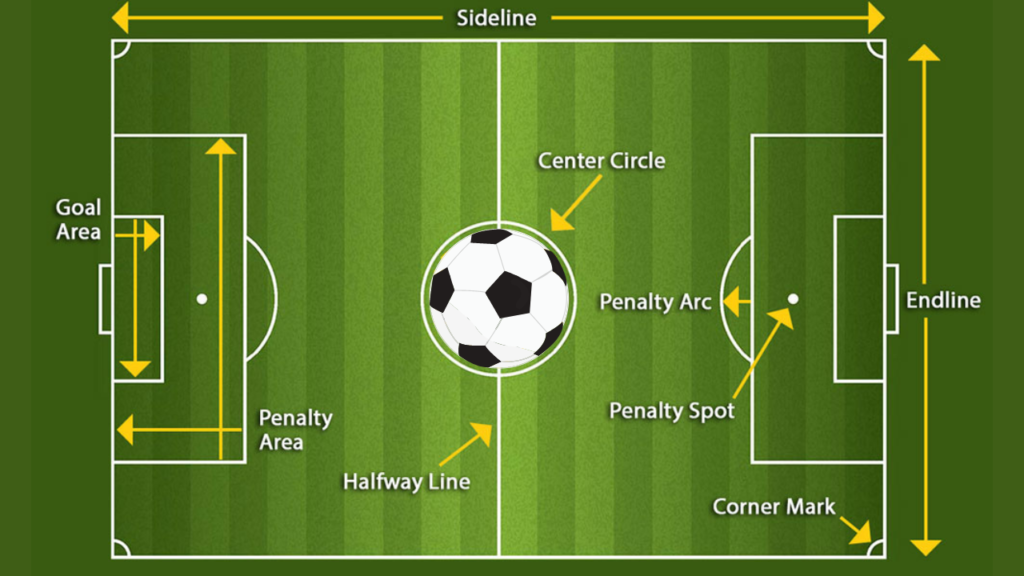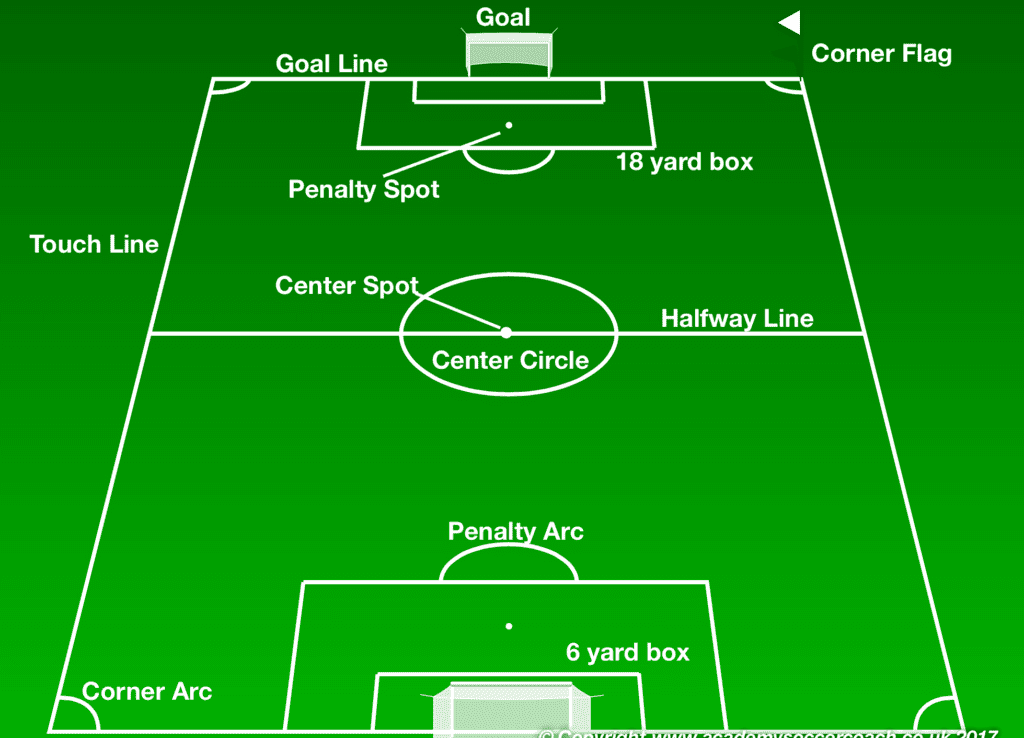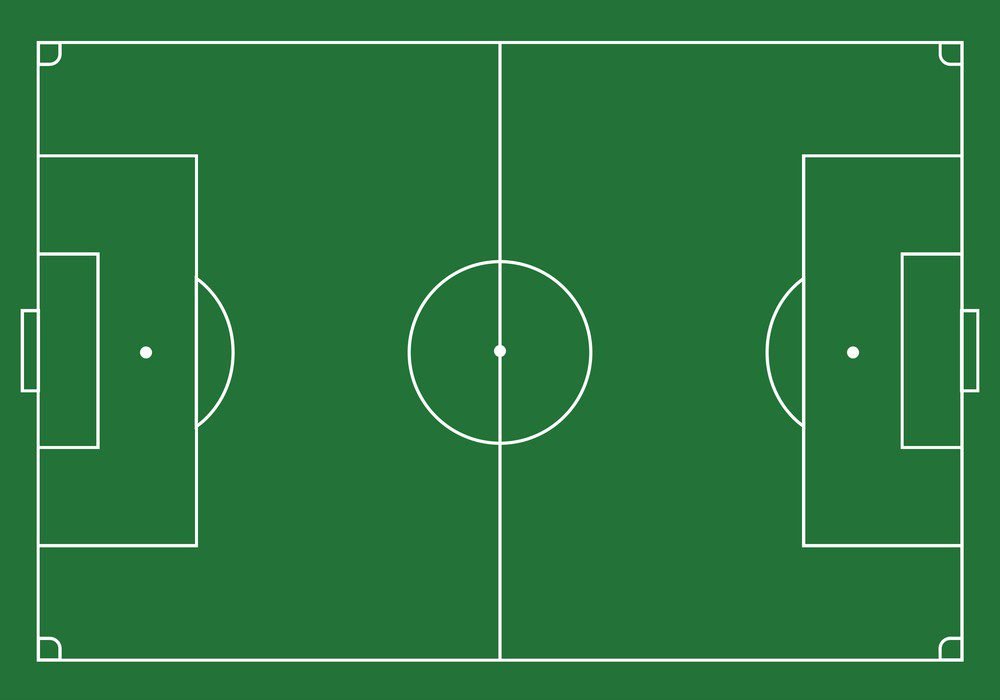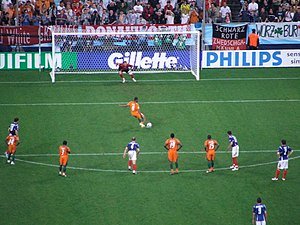- Last Updated -
What is the 6-Yard Box in Soccer?
The soccer 6-yard Box is defined as a small rectangular area nestled adjacent to each goal post, the 6-yard box is an integral component of the broader goal area, extending outward from the goal line to a span of 18 yards.
Its dimensions are six yards from each goalpost towards the field’s center and extending six yards into the pitch from these points, are meticulously delineated to serve a multifaceted purpose.
For defenders, the 6-yard box stands as a bastion of protection around their custodians, affording them the latitude to clear threatening balls without the specter of infringing upon opponents and incurring penalties.
Meanwhile, for attackers, it represents a tantalizing arena for exploiting close-range opportunities, ripe for piercing through the defensive barricades and unleashing potent shots on goal.
In terms of soccer rules, specific regulations surrounding how players can interact with this part of the field. For example, a goalkeeper may not hold onto or touch any ball that was intentionally kicked by a teammate within this zone – otherwise known as an indirect free-kick offense – unless an opposing player first touches it.
Players are not allowed to interfere with any opponent within this box during corner kick set pieces as they aim for headers toward the goal. Now that we’ve covered some basics about what exactly is meant by “soccer 6-yard Box,” we’ll get into more detail about its history and how it differs from other parts on football pitches in our next sections!

What is the 6-Yard Box in Soccer?
The 6-Yard Box is an important area on a soccer field that is situated in front of the goal. This box is rectangular and measures six yards from the goal line and extends six yards into the field.
The 6-Yard Box can also be referred to as the “Goal Area” or “Goalkeeper’s Area”. This section of the field plays a crucial role in determining how teams strategize and execute their offensive plays, as well as how defenders maneuver to protect their goal.
This area of the soccer pitch has specific rules that apply only to it. For example, when a defending team commits a foul inside their 6-yard box, then an indirect free-kick is awarded to the attacking team.
Additionally, all opponents must stand outside of this box during corner kicks to give the goalkeeper room to move freely and make saves. The goalkeeper can also handle any ball within this area, without fear of being challenged by opposing players.
The purpose of having this box on a soccer field is mainly for safety reasons. It allows for space around the goalkeeper so they can safely make saves without getting injured by nearby opponents.
Also, it provides some structure on where players should stand during set-piece plays such as corner kicks or penalty kicks, making it easier for referees to enforce soccer rules effectively.
Understanding these rules associated with the 6-Yard Box is essential for any soccer player or spectator who wants to fully appreciate how this part of a football ground impacts gameplay on match day!

Quick Takeaways
The soccer 6-yard Box is an essential part of the soccer field that serves as a goalkeeper’s protected area, and it has its own set of rules.
This small rectangular area is located at the center of the penalty area, and it measures six yards across from each goalpost. The 6-yard box has two main purposes in soccer.
Firstly, it acts as a guide for the placement of corner kicks, providing both teams with a clear position to start from when taking their corners.
Secondly, it serves as a safe zone for goalkeepers to protect themselves while they attempt to clear the ball out of their penalty area.
The box is an integral part of soccer rules and is often used in various ways throughout a soccer game. For instance, if a goalkeeper takes too long inside the 6-yard box during a goal kick, an indirect free-kick will be awarded to the opposing team under Soccer Rules.
Additionally, any opposition attempting to challenge for possession inside this box will result in a foul being awarded to the goalkeeper’s team.
Understanding these rules can make all the difference in how effectively you play within these zones on any Football Pitch or Soccer Field you find yourself playing on.
The Purpose of the Soccer 6-yard Box
The soccer 6-yard Box is an important part of the penalty area, and it serves several distinct purposes on the football pitch. The most obvious role of the 6-yard box is to provide a designated space for goalkeepers during goal kicks, which are taken from inside this area.
This rule ensures that all opposing players are outside the 6-yard box when a goal kick is taken, giving the goalkeeper more space and time to make an accurate pass.
In addition to creating a safe zone for goal kicks, the 6-yard box also plays a crucial role in determining fouls and penalties during a soccer game. If an opposing player commits a foul within the 6-yard box, then the attacking team may be awarded a penalty kick.
This can often lead to high-pressure situations during games where players must carefully navigate this small but important area without committing any fouls. The purpose of the 6-yard box extends beyond just its physical dimensions on the field.
This area helps create strategic opportunities for teams during set pieces like corner kicks or free kicks near their opponent’s goal line. Because defenders must remain outside of this area during these situations, attackers can use this extra space to create scoring opportunities with headers or well-placed shots.
Overall, while it may seem like just another set of lines on the soccer field, the 6-yard box serves several unique and important roles in every game played on a football ground.
From providing designated space for goalkeepers to creating tactical advantages for attacking teams, this small but critical area helps define many of soccer’s most exciting moments.
The History of the 6-Yard Box
The 6-yard box has been an integral part of soccer rules and regulations since the early 1900s. The box was first introduced following the decision to allow goalkeepers to handle the ball inside their penalty area.
Before this, any player could touch the ball with their hands, but this changed in 1891 when it became illegal for players to use their hands or arms in any way except for the goalkeeper within their designated area.
This led to the creation of a new rule that stated that opposing players must stay at least six yards away from the goalkeeper when they are taking a goal kick.
Originally, the 6-yard box had a circular shape, and its radius was set at six yards from each goal post. However, in 1902, this was changed to its current rectangular shape as it made more sense for both players and referees.
The purpose of this change was two-fold: first, it made it easier for referees to determine whether a goalkeeper had committed an offense by stepping outside of his designated area; second, it ensured that attackers did not get too close to the goalkeeper when he tried to clear his lines.
Over time, soccer rules were amended further as teams developed different tactics and styles of play.
For example, changes were made to offside rules and how they applied within the 6-yard box. Additionally, many teams began employing tactics known as “parking the bus,” where defenders would place themselves in front of their goal line during long stretches of play to block opposition attacks.
While some changes have been made over time regarding other soccer rules such as offside or penalty kicks areas on soccer fields worldwide have remained relatively analogous since they were initially introduced over a century ago.
The rectangular-shaped 6-yard box remains an integral part of today’s game and serves as a reminder of soccer’s rich history and how far it has come since its inception.
6-Yard Box vs. 18-Yard Box
When watching a soccer game, you might have noticed that there are two boxes marked in front of each goal. These boxes are called the 6-yard box and the 18-yard box, and they serve different purposes.
The 6-yard box is located directly in front of the goal mouth, and it is where the goalkeeper can handle the ball with their hands. The size of this box is 20 yards wide and 6 yards deep, or approximately 18.3 meters by 5.5 meters.
On the other hand, the 18-yard box is larger and located just outside the smaller box. It serves as a penalty area where fouls committed by defenders result in a free kick to be taken from inside this area by the attacking team.
The size of this box is 44 yards wide and 18 yards deep or about 40 meters by 16 meters. The purpose of having two different boxes on a football pitch is to differentiate between areas where different rules apply.
For instance, when taking a goal kick from inside their penalty area, players must place the ball anywhere within this six-yard area before kicking it out into play again. Moreover, any fouls committed inside the penalty area (the larger one) result in either a penalty kick or free-kick depending upon whether it’s an offensive or defensive foul respectively.
Both boxes serve important roles in soccer rules and gameplay.
While they may appear similar at first glance, there are significant differences between them that have an impact on how players approach certain situations during a match on any football ground worldwide.

Interesting Facts about the 6-Yard Box
The 6-yard box in soccer may seem like a small area on the pitch, but it has some interesting facts that are worth knowing. One of the most exciting facts about this box is that it is exclusively for goalkeepers, meaning that outfield players cannot enter or touch the ball while inside it.
It serves as a home base for goalkeepers during corner kicks and set-pieces, allowing them to organize their defense and make quick decisions. Another interesting fact about the 6-yard box is that it is also known as the “goal area“.
This term comes from the fact that the goalkeeper has special privileges in this area, including being able to handle the ball without committing a foul. The goal area itself is marked by two lines parallel to each other and perpendicular to the goal line, with one line being drawn 6 yards away from where the goal posts meet.
Interestingly enough, if an opposing player enters this restricted zone during gameplay, they can be penalized with a free-kick or even a yellow card if they obstruct or interfere with any goalkeeper’s movements.
Moreover, if someone fouls another player within this little space during gameplay, then a penalty kick may be awarded to move forward with an attempt at scoring.
These interesting facts show just how important and unique the 6-yard box is in soccer. From defining goalkeeper’s rights and privileges to determining who gets penalized for entering into its confines during gameplay – this tiny box plays a big role in every soccer match you watch!
FAQs
Why is there a 6-yard box in soccer?
The 6-yard box in soccer serves as the area where the goalkeeper can exercise his/her authority and perform their duties without interference from the opposing team.
The box allows for a safer environment for the goalkeeper to collect and handle the ball without fear of getting tackled. It also decreases the chance of an opposing player standing too close to the keeper, which could lead to a foul or penalty.
What is the difference between the 6-yard box and the 18-yard box?
The main difference between these two boxes is their purpose.
The 6-yard box serves as a safety zone for goalkeepers, whereas the 18-yard box, also known as the “penalty area,” marks where fouls committed by defenders could result in penalty kicks for attacking teams. Additionally, any goals scored from within this area count as two points.
What do the boxes in soccer mean?
The boxes on a soccer field have specific meanings and purposes:
– The Penalty Area: This area marks where fouls committed by defenders inside this zone can result in penalty kicks. – The Goal Area: Also called “the six,” or “six-yard box,” it is used to determine where goal kicks are taken.
– The Goal Line: Marks the line over which attackers must cross to score. If any part of this line is crossed while holding onto or carrying an object (such as a ball), it results in an out-of-bounds play.
Can you be offside in the 6-yard box?
No, players cannot be offside inside their half of play (where their goalpost stands) nor inside either of their opponents’ “boxes” (the penalty area and six yard-box).
They can only be offside when they’re closer to their opponent’s goal than both the ball and the second-last defender at the time of the pass.
Can a goalkeeper be touched in the 6-yard box?
A goalkeeper in the 6-yard box is protected by the “goalkeeper rule,” which means that opposing players cannot touch them or interfere with their performance.
However, if the goalkeeper comes out of the box and crosses over to another area of the soccer field, they lose this protection.

Conclusion
The 6-Yard Box in soccer is an important part of the game that serves multiple functions.
It is a necessary element in defining the goal area and providing clear rules for attacking players. This small box carries a significant value and can decide the outcome of games with penalties or goal kicks.
The 6-yard box has experienced many changes throughout soccer’s history, but it remains a crucial part of the sport today. With its unique size and positioning, it provides challenges for both attackers and defenders.
Many iconic moments have happened within this small box on football grounds all over the world. Overall, understanding soccer rules such as those regarding the 6-yard box can help deepen appreciation for this beautiful game.
Whether one is playing on a football pitch or watching their favorite soccer team compete, recognizing how each aspect contributes to gameplay can make for an even more enjoyable experience. So next time you see a goalkeeper positioned inside that little area, remember just how much strategy and skill goes into every decision made within those 6 yards! (1)
Concussion Substitutions in Soccer: evolving concussion protocols
The Growing Concern for Player Safety in Soccer Soccer, a beloved sport...
Read MoreThe Historical Dominance of Brazilian Soccer in the World Cup
Introduction: The Beautiful Game's Grandest Stage The World Cup, a grand tournament...
Read More



















